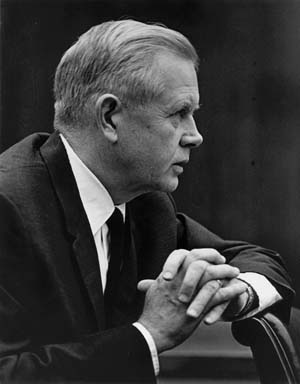Gerald Tape: Difference between revisions
No edit summary |
No edit summary |
||
| Line 1: | Line 1: | ||
== | == Biography == | ||
[[Image:Tape 1968.jpg|thumb| | [[Image:Tape 1968.jpg|thumb|right|Image:Tape_1968.jpg]] | ||
Natural curiosity and an interest in science led Tape into a career that spanned some of the most important scientific milestones of the 20th century. From the development of radar during World War II to the establishment of radio astronomy observatories and high-energy physics laboratories to explore the universe, his patience, integrity, and tireless dedication helped scientists around the world further our knowledge. | Natural curiosity and an interest in science led Tape into a career that spanned some of the most important scientific milestones of the 20th century. From the development of radar during World War II to the establishment of radio astronomy observatories and high-energy physics laboratories to explore the universe, his patience, integrity, and tireless dedication helped scientists around the world further our knowledge. | ||
| Line 27: | Line 27: | ||
Tape was a Fellow of the American Physical Society, the American Nuclear Society, and the American Association for the Advancement of Science. He was a member of the National Academy of Engineering, the American Astronomical Society, and the Atomic Industrial Forum. | Tape was a Fellow of the American Physical Society, the American Nuclear Society, and the American Association for the Advancement of Science. He was a member of the National Academy of Engineering, the American Astronomical Society, and the Atomic Industrial Forum. | ||
Tape, a long-time Washington science advisor and policy-maker, died November 20, 2005, after a long illness, in Bethesda, Maryland. | Tape, a long-time Washington science advisor and policy-maker, died November 20, 2005, after a long illness, in Bethesda, Maryland. | ||
[[Category:Fields, | [[Category:Fields, waves & electromagnetics|Tape]] [[Category:Radio astronomy|Tape]] [[Category:General topics for engineers|Tape]] [[Category:Scientific disciplines|Tape]] [[Category:Physics|Tape]] | ||
Revision as of 21:19, 18 January 2012
Biography
Natural curiosity and an interest in science led Tape into a career that spanned some of the most important scientific milestones of the 20th century. From the development of radar during World War II to the establishment of radio astronomy observatories and high-energy physics laboratories to explore the universe, his patience, integrity, and tireless dedication helped scientists around the world further our knowledge.
Jerry, as he was known to all, was born in Ann Arbor, Michigan in 1915. Tape received his B.A. degree from Eastern Michigan University in 1935 and his PhD under J. M. Cork from the University of Michigan in 1940. He taught physics at Cornell until the outbreak of World War II, at which time he joined the Radiation Laboratory at MIT to help in the development of radar.
At the Rad Lab he worked in the Indicators Group under Robert Bacher, was project leader for relay radar, and was in charge of airborne radar for the British Branch of the lab from October 1944 to June 1945. It was at the Rad Lab that Tape made the contacts and learned the communication skills that would serve him well later, especially in conveying scientific and technological concepts to the military, government, and academic communities.
After the war Tape taught physics and worked with the cyclotron at the University of Illinois. In 1950 he went to the Brookhaven National Laboratory as assistant to the director, Leland Haworth, and a year later was named Deputy Director. During Tape s years at Brookhaven, a number of major science facilities were completed, including the Cosmotron (1953), the Alternating Gradient Synchrotron (1960), and the Brookhaven Medical Research Reactor (1959).
During the periods 1962-63 and 1969-80 Tape served as president of Associated Universities, Inc, which managed Brookhaven for the Atomic Energy Commission and managed the National Radio Astronomy Observatory for the National Science Foundation.
In 1963 President Kennedy appointed Tape to the Atomic Energy Commission (AEC), where he served until 1969. Among other AEC activities, Tape specialized in nuclear weapons oversight and had frequent contact with the Los Alamos, Livermore, and Sandia labs, as well as with the Nevada Test Site.
In 1973 President Nixon named him U.S. representative to the International Atomic Energy Agency (IAEA) with the rank of ambassador, a post he held until January 1977. These were dynamic times at the IAEA; the Treaty on the Nonproliferation of Nuclear Weapons had recently taken effect, the IAEA s full-scope safeguards system was under development, and nuclear technology and cooperation were expanding.
Tape was often sought out to provide science advice, including serving on the President's Science Advisory Committee and on the Defense Science Board, where he often chaired its summer study program. He also chaired the CIA's Nuclear Intelligence Panel.
Tape believed strongly in the importance of communicating science to the public. He served on the Board of Trustees of Science Service, which manages high school science fairs and publishes Science News.
In 1987 Tape was awarded the Department of Energy s highest honor, the Fermi Award. The citation reads For a distinguished career in the administration, development, and advancement of U.S. and international atomic energy, as well as contributions to the nonproliferation of nuclear weapons, with special recognition for his integrity.
Other awards include the Department of State s Tribute of Appreciation, the Secretary of Defense's Meritorious Civilian Service Medal, the Department of Defense's Distinguished Public Service Medal, the Department of Energy's Distinguished Associate Award, and the National Science Foundation's Distinguished Public Service Award. The Atomic Industrial Forum and the American Nuclear Society granted him the Henry Dewolf Smyth Nuclear Statesman Award.
Tape was a Fellow of the American Physical Society, the American Nuclear Society, and the American Association for the Advancement of Science. He was a member of the National Academy of Engineering, the American Astronomical Society, and the Atomic Industrial Forum.
Tape, a long-time Washington science advisor and policy-maker, died November 20, 2005, after a long illness, in Bethesda, Maryland.
